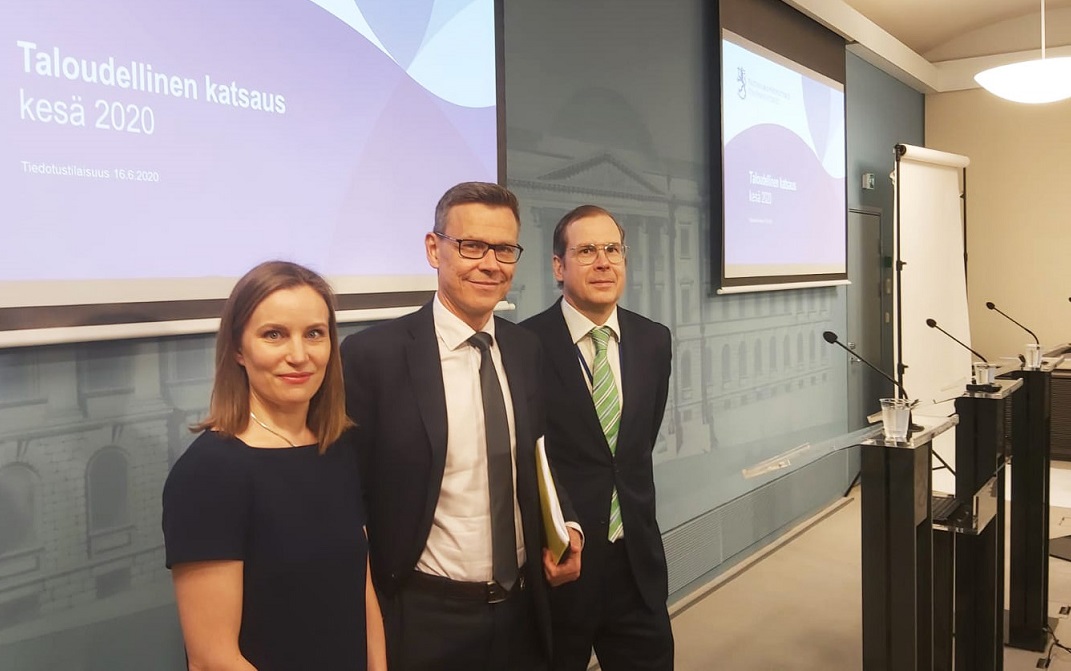Govt forecasts economy to shrink by 6% in 2020
Published : 16 Jun 2020, 19:27
Updated : 17 Jun 2020, 02:07
The Finnish economy will shrink 6% this year, according to the forecast of the Ministry of Finance in its latest Economic Survey published on Tuesday.
The economy will shrink considerably this year as a result of the coronavirus pandemic and the restrictive measures taken to mitigate the spread of the virus.
The lifting of restrictions, which was started at the beginning of June, will nevertheless boost economic activity, especially in the service sector. The economy will begin to pick up slowly at the end of 2020, and gross domestic product (GDP) is then estimated to grow by 2.5% in 2021 and by 1.7% in 2022.
However, a recovery in the economy will depend on there being a significant improvement in the outlook on export markets and rising confidence in the ability of Finland’s economy to generate growth and create jobs.
Debt is being accumulated this year in general government finances at an extremely rapid rate. The general government deficit will climb to over 8%, and the ratio of general government debt to GDP will rise to approximately 71%.
The imbalance between revenue and expenditure will decrease in the next few years as the temporary support measures come to an end and economic growth picks up. General government finances will nevertheless still be significantly in deficit as the mid-2020s approach.
“The financial support for businesses and for employment and economic activity will get us through the crisis, but this support also weakens public finances considerably. Besides recovery and rebuilding, we need to decide soon on measures to stabilise the long-term management of public finances,” said Mikko Spolander, Director General of the Economics Department at the Ministry of Finance.
The Government's lifting of specified COVID-19 restrictions at the start of June will bring growth in the consumption of services in the third quarter of 2020.
The consumption of goods and of most services will show a return to normal in the first half of 2021. The slowest return will be in tourism and travel services.
For 2020 as a whole, private consumption will nevertheless be down by 3.5%, but will then grow by a similar rate in 2021. Private investment in 2020 will be down by more than 9%, but slight growth will then be seen in 2021.
In construction, the level of growth in the first half of this year was slightly higher than had been anticipated, but investment in residential construction will nevertheless be down for the full year 2020. It is expected that new construction projects will be postponed, which will further weaken residential construction investment in 2021.
Exports decreased by volume in the first quarter of this year, and the decline continued in the second quarter. With summer arriving, Finland’s main trading partners will nevertheless be starting phased removals of COVID-19 containment measures, and economic activity will be showing signs of revival. Exports will also start to grow in the second six months of this year. Service exports will pick up more slowly than exports of goods.
The number of people in employment will show a steep decline for 2020. Employment will be down by 2.5%, bringing the employment rate to below 71%. Businesses have adjusted their labour costs downwards through job losses but also by laying off staff. The number of laid-off jobseekers grew at an unparalleled rate in the spring. Due to the large number of lay-offs and the drop in employment, the unemployment rate for 2020 will rise to 8.5%.
The first half of the year saw a significant number of new collective agreements signed. The increases agreed in nominal pay amount to an average of almost 1.5%.
The 2020 inflation rate, as measured by the Consumer Price Index, is forecast to be 0.3%. Inflation has been kept in check by the significant drop in consumer demand and the existence of uncertainty over the future course of the economy, and these will continue to curb inflation over the coming years.


